Detailed Examination of Business Finance: Sources of Funds
VerifiedAdded on 2021/12/22
|9
|1869
|47
Report
AI Summary
This report provides a comprehensive overview of various sources of finance available to businesses. It explores key funding options such as self-financing, bank loans, equity share capital, preference share capital, and retained earnings. Each source is analyzed in detail, discussing its advantages and disadvantages, and how each impacts a company's financial structure. The report also touches upon important aspects like the role of financial managers in deciding capital structure, emphasizing factors like company size, operational scale, and the nature of business activities. The conclusion stresses the importance of selecting the optimal capital structure to minimize the cost of capital and ensure smooth business operations. The report includes a bibliography of sources used.

ACCOUNTING
Paraphrase This Document
Need a fresh take? Get an instant paraphrase of this document with our AI Paraphraser
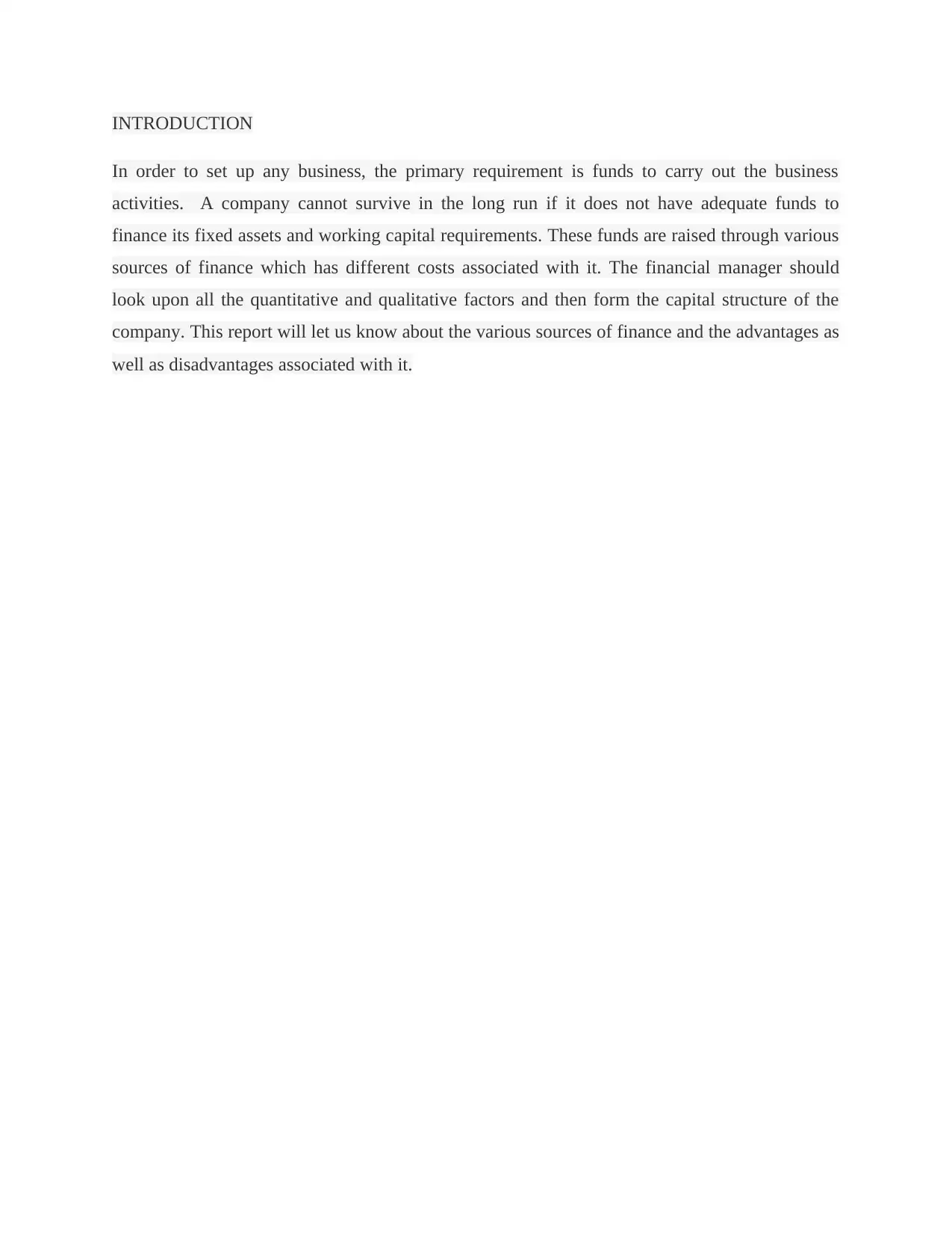
INTRODUCTION
In order to set up any business, the primary requirement is funds to carry out the business
activities. A company cannot survive in the long run if it does not have adequate funds to
finance its fixed assets and working capital requirements. These funds are raised through various
sources of finance which has different costs associated with it. The financial manager should
look upon all the quantitative and qualitative factors and then form the capital structure of the
company. This report will let us know about the various sources of finance and the advantages as
well as disadvantages associated with it.
In order to set up any business, the primary requirement is funds to carry out the business
activities. A company cannot survive in the long run if it does not have adequate funds to
finance its fixed assets and working capital requirements. These funds are raised through various
sources of finance which has different costs associated with it. The financial manager should
look upon all the quantitative and qualitative factors and then form the capital structure of the
company. This report will let us know about the various sources of finance and the advantages as
well as disadvantages associated with it.
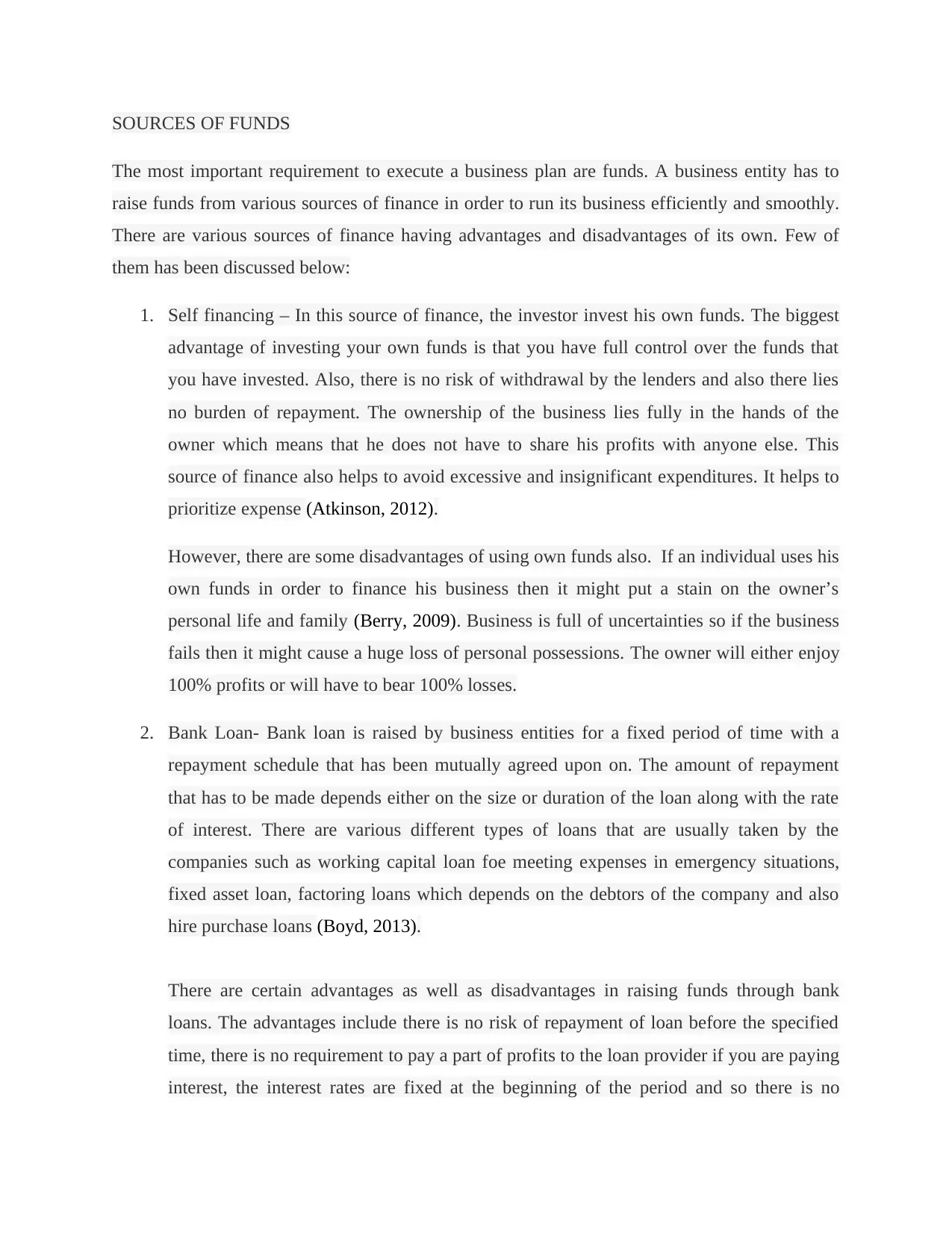
SOURCES OF FUNDS
The most important requirement to execute a business plan are funds. A business entity has to
raise funds from various sources of finance in order to run its business efficiently and smoothly.
There are various sources of finance having advantages and disadvantages of its own. Few of
them has been discussed below:
1. Self financing – In this source of finance, the investor invest his own funds. The biggest
advantage of investing your own funds is that you have full control over the funds that
you have invested. Also, there is no risk of withdrawal by the lenders and also there lies
no burden of repayment. The ownership of the business lies fully in the hands of the
owner which means that he does not have to share his profits with anyone else. This
source of finance also helps to avoid excessive and insignificant expenditures. It helps to
prioritize expense (Atkinson, 2012).
However, there are some disadvantages of using own funds also. If an individual uses his
own funds in order to finance his business then it might put a stain on the owner’s
personal life and family (Berry, 2009). Business is full of uncertainties so if the business
fails then it might cause a huge loss of personal possessions. The owner will either enjoy
100% profits or will have to bear 100% losses.
2. Bank Loan- Bank loan is raised by business entities for a fixed period of time with a
repayment schedule that has been mutually agreed upon on. The amount of repayment
that has to be made depends either on the size or duration of the loan along with the rate
of interest. There are various different types of loans that are usually taken by the
companies such as working capital loan foe meeting expenses in emergency situations,
fixed asset loan, factoring loans which depends on the debtors of the company and also
hire purchase loans (Boyd, 2013).
There are certain advantages as well as disadvantages in raising funds through bank
loans. The advantages include there is no risk of repayment of loan before the specified
time, there is no requirement to pay a part of profits to the loan provider if you are paying
interest, the interest rates are fixed at the beginning of the period and so there is no
The most important requirement to execute a business plan are funds. A business entity has to
raise funds from various sources of finance in order to run its business efficiently and smoothly.
There are various sources of finance having advantages and disadvantages of its own. Few of
them has been discussed below:
1. Self financing – In this source of finance, the investor invest his own funds. The biggest
advantage of investing your own funds is that you have full control over the funds that
you have invested. Also, there is no risk of withdrawal by the lenders and also there lies
no burden of repayment. The ownership of the business lies fully in the hands of the
owner which means that he does not have to share his profits with anyone else. This
source of finance also helps to avoid excessive and insignificant expenditures. It helps to
prioritize expense (Atkinson, 2012).
However, there are some disadvantages of using own funds also. If an individual uses his
own funds in order to finance his business then it might put a stain on the owner’s
personal life and family (Berry, 2009). Business is full of uncertainties so if the business
fails then it might cause a huge loss of personal possessions. The owner will either enjoy
100% profits or will have to bear 100% losses.
2. Bank Loan- Bank loan is raised by business entities for a fixed period of time with a
repayment schedule that has been mutually agreed upon on. The amount of repayment
that has to be made depends either on the size or duration of the loan along with the rate
of interest. There are various different types of loans that are usually taken by the
companies such as working capital loan foe meeting expenses in emergency situations,
fixed asset loan, factoring loans which depends on the debtors of the company and also
hire purchase loans (Boyd, 2013).
There are certain advantages as well as disadvantages in raising funds through bank
loans. The advantages include there is no risk of repayment of loan before the specified
time, there is no requirement to pay a part of profits to the loan provider if you are paying
interest, the interest rates are fixed at the beginning of the period and so there is no
⊘ This is a preview!⊘
Do you want full access?
Subscribe today to unlock all pages.

Trusted by 1+ million students worldwide
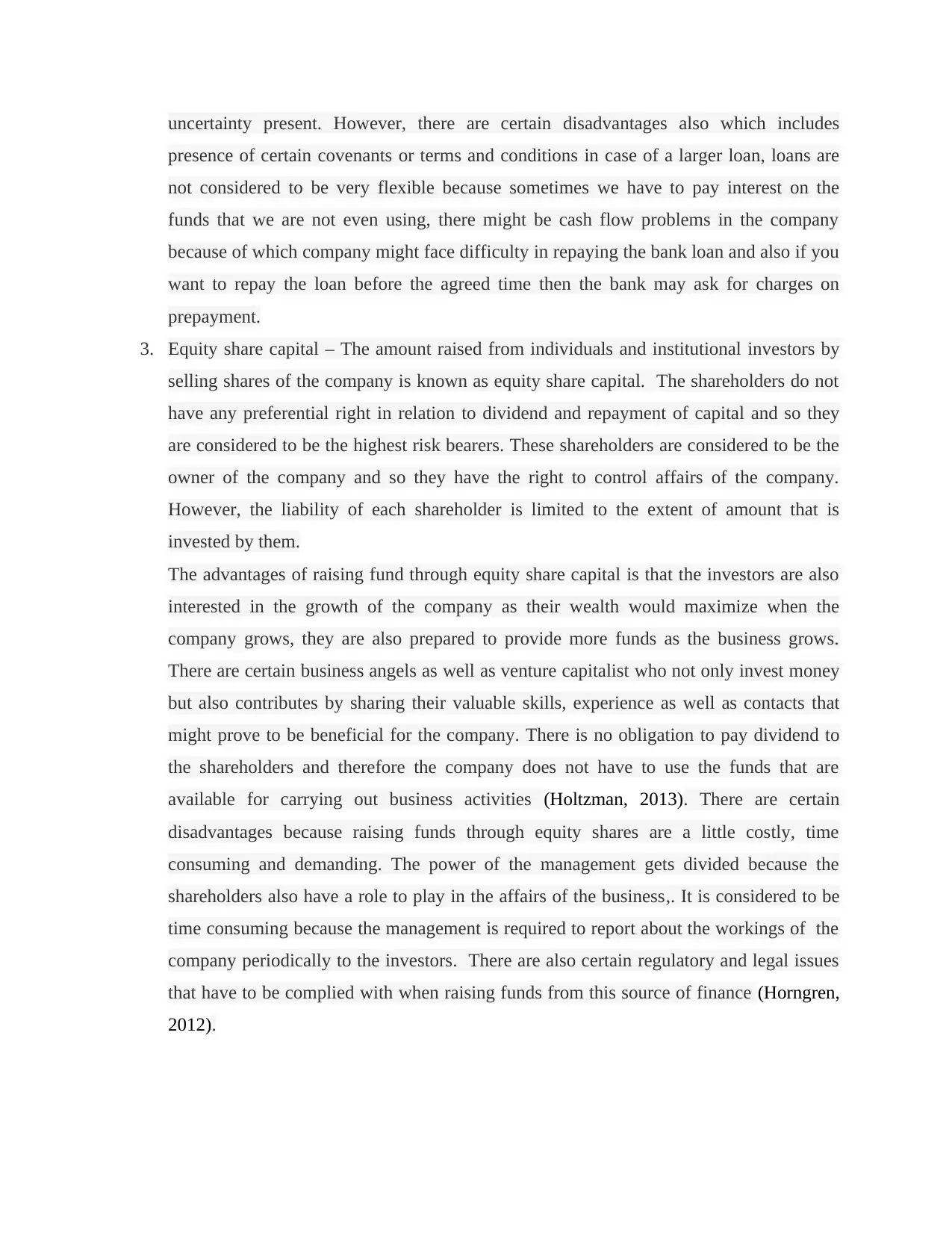
uncertainty present. However, there are certain disadvantages also which includes
presence of certain covenants or terms and conditions in case of a larger loan, loans are
not considered to be very flexible because sometimes we have to pay interest on the
funds that we are not even using, there might be cash flow problems in the company
because of which company might face difficulty in repaying the bank loan and also if you
want to repay the loan before the agreed time then the bank may ask for charges on
prepayment.
3. Equity share capital – The amount raised from individuals and institutional investors by
selling shares of the company is known as equity share capital. The shareholders do not
have any preferential right in relation to dividend and repayment of capital and so they
are considered to be the highest risk bearers. These shareholders are considered to be the
owner of the company and so they have the right to control affairs of the company.
However, the liability of each shareholder is limited to the extent of amount that is
invested by them.
The advantages of raising fund through equity share capital is that the investors are also
interested in the growth of the company as their wealth would maximize when the
company grows, they are also prepared to provide more funds as the business grows.
There are certain business angels as well as venture capitalist who not only invest money
but also contributes by sharing their valuable skills, experience as well as contacts that
might prove to be beneficial for the company. There is no obligation to pay dividend to
the shareholders and therefore the company does not have to use the funds that are
available for carrying out business activities (Holtzman, 2013). There are certain
disadvantages because raising funds through equity shares are a little costly, time
consuming and demanding. The power of the management gets divided because the
shareholders also have a role to play in the affairs of the business,. It is considered to be
time consuming because the management is required to report about the workings of the
company periodically to the investors. There are also certain regulatory and legal issues
that have to be complied with when raising funds from this source of finance (Horngren,
2012).
presence of certain covenants or terms and conditions in case of a larger loan, loans are
not considered to be very flexible because sometimes we have to pay interest on the
funds that we are not even using, there might be cash flow problems in the company
because of which company might face difficulty in repaying the bank loan and also if you
want to repay the loan before the agreed time then the bank may ask for charges on
prepayment.
3. Equity share capital – The amount raised from individuals and institutional investors by
selling shares of the company is known as equity share capital. The shareholders do not
have any preferential right in relation to dividend and repayment of capital and so they
are considered to be the highest risk bearers. These shareholders are considered to be the
owner of the company and so they have the right to control affairs of the company.
However, the liability of each shareholder is limited to the extent of amount that is
invested by them.
The advantages of raising fund through equity share capital is that the investors are also
interested in the growth of the company as their wealth would maximize when the
company grows, they are also prepared to provide more funds as the business grows.
There are certain business angels as well as venture capitalist who not only invest money
but also contributes by sharing their valuable skills, experience as well as contacts that
might prove to be beneficial for the company. There is no obligation to pay dividend to
the shareholders and therefore the company does not have to use the funds that are
available for carrying out business activities (Holtzman, 2013). There are certain
disadvantages because raising funds through equity shares are a little costly, time
consuming and demanding. The power of the management gets divided because the
shareholders also have a role to play in the affairs of the business,. It is considered to be
time consuming because the management is required to report about the workings of the
company periodically to the investors. There are also certain regulatory and legal issues
that have to be complied with when raising funds from this source of finance (Horngren,
2012).
Paraphrase This Document
Need a fresh take? Get an instant paraphrase of this document with our AI Paraphraser
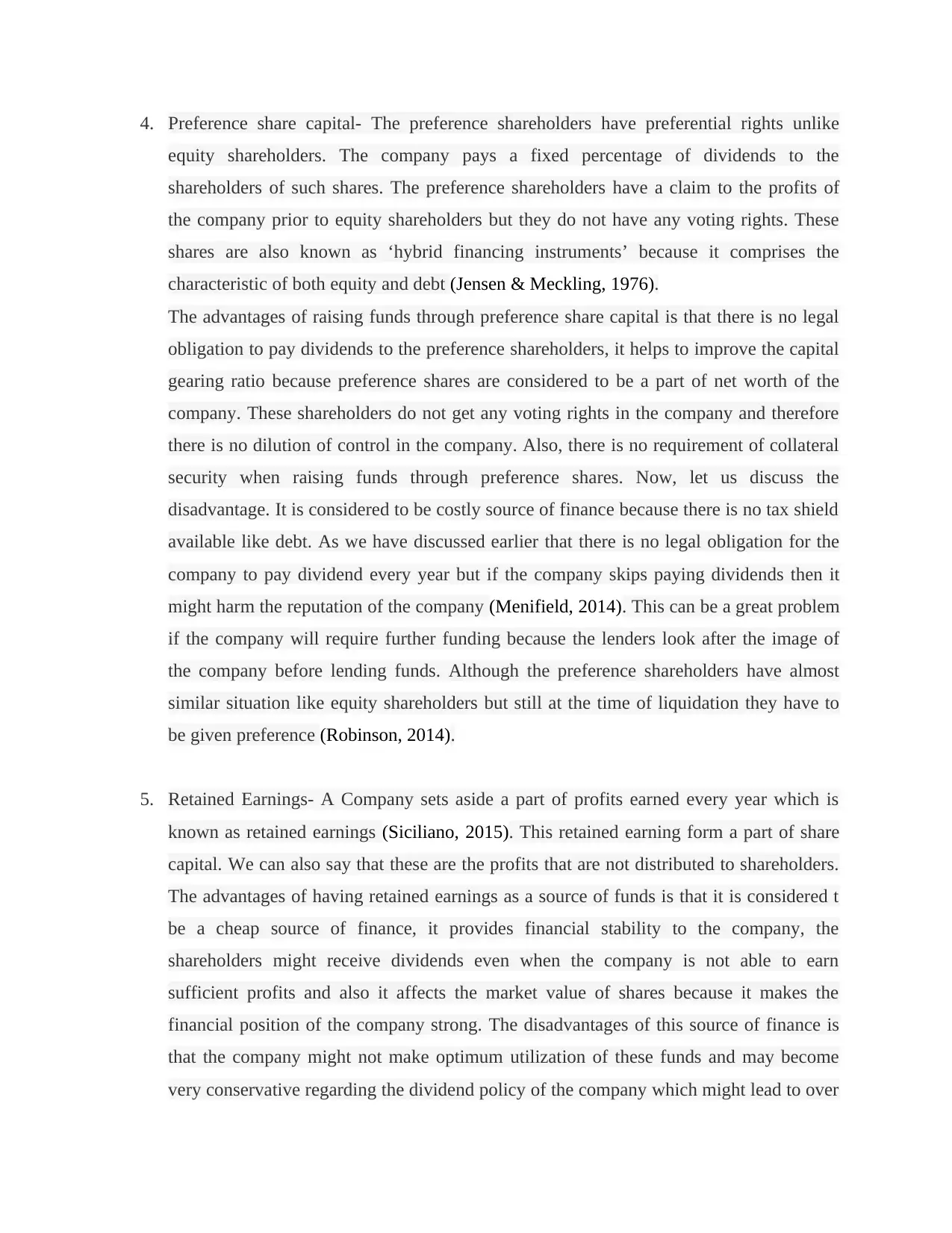
4. Preference share capital- The preference shareholders have preferential rights unlike
equity shareholders. The company pays a fixed percentage of dividends to the
shareholders of such shares. The preference shareholders have a claim to the profits of
the company prior to equity shareholders but they do not have any voting rights. These
shares are also known as ‘hybrid financing instruments’ because it comprises the
characteristic of both equity and debt (Jensen & Meckling, 1976).
The advantages of raising funds through preference share capital is that there is no legal
obligation to pay dividends to the preference shareholders, it helps to improve the capital
gearing ratio because preference shares are considered to be a part of net worth of the
company. These shareholders do not get any voting rights in the company and therefore
there is no dilution of control in the company. Also, there is no requirement of collateral
security when raising funds through preference shares. Now, let us discuss the
disadvantage. It is considered to be costly source of finance because there is no tax shield
available like debt. As we have discussed earlier that there is no legal obligation for the
company to pay dividend every year but if the company skips paying dividends then it
might harm the reputation of the company (Menifield, 2014). This can be a great problem
if the company will require further funding because the lenders look after the image of
the company before lending funds. Although the preference shareholders have almost
similar situation like equity shareholders but still at the time of liquidation they have to
be given preference (Robinson, 2014).
5. Retained Earnings- A Company sets aside a part of profits earned every year which is
known as retained earnings (Siciliano, 2015). This retained earning form a part of share
capital. We can also say that these are the profits that are not distributed to shareholders.
The advantages of having retained earnings as a source of funds is that it is considered t
be a cheap source of finance, it provides financial stability to the company, the
shareholders might receive dividends even when the company is not able to earn
sufficient profits and also it affects the market value of shares because it makes the
financial position of the company strong. The disadvantages of this source of finance is
that the company might not make optimum utilization of these funds and may become
very conservative regarding the dividend policy of the company which might lead to over
equity shareholders. The company pays a fixed percentage of dividends to the
shareholders of such shares. The preference shareholders have a claim to the profits of
the company prior to equity shareholders but they do not have any voting rights. These
shares are also known as ‘hybrid financing instruments’ because it comprises the
characteristic of both equity and debt (Jensen & Meckling, 1976).
The advantages of raising funds through preference share capital is that there is no legal
obligation to pay dividends to the preference shareholders, it helps to improve the capital
gearing ratio because preference shares are considered to be a part of net worth of the
company. These shareholders do not get any voting rights in the company and therefore
there is no dilution of control in the company. Also, there is no requirement of collateral
security when raising funds through preference shares. Now, let us discuss the
disadvantage. It is considered to be costly source of finance because there is no tax shield
available like debt. As we have discussed earlier that there is no legal obligation for the
company to pay dividend every year but if the company skips paying dividends then it
might harm the reputation of the company (Menifield, 2014). This can be a great problem
if the company will require further funding because the lenders look after the image of
the company before lending funds. Although the preference shareholders have almost
similar situation like equity shareholders but still at the time of liquidation they have to
be given preference (Robinson, 2014).
5. Retained Earnings- A Company sets aside a part of profits earned every year which is
known as retained earnings (Siciliano, 2015). This retained earning form a part of share
capital. We can also say that these are the profits that are not distributed to shareholders.
The advantages of having retained earnings as a source of funds is that it is considered t
be a cheap source of finance, it provides financial stability to the company, the
shareholders might receive dividends even when the company is not able to earn
sufficient profits and also it affects the market value of shares because it makes the
financial position of the company strong. The disadvantages of this source of finance is
that the company might not make optimum utilization of these funds and may become
very conservative regarding the dividend policy of the company which might lead to over

capitalization, the shareholders of the company may get dissatisfied if the company does
not provide them dividends from the earnings of the company (Simpson, 2012).
not provide them dividends from the earnings of the company (Simpson, 2012).
⊘ This is a preview!⊘
Do you want full access?
Subscribe today to unlock all pages.

Trusted by 1+ million students worldwide
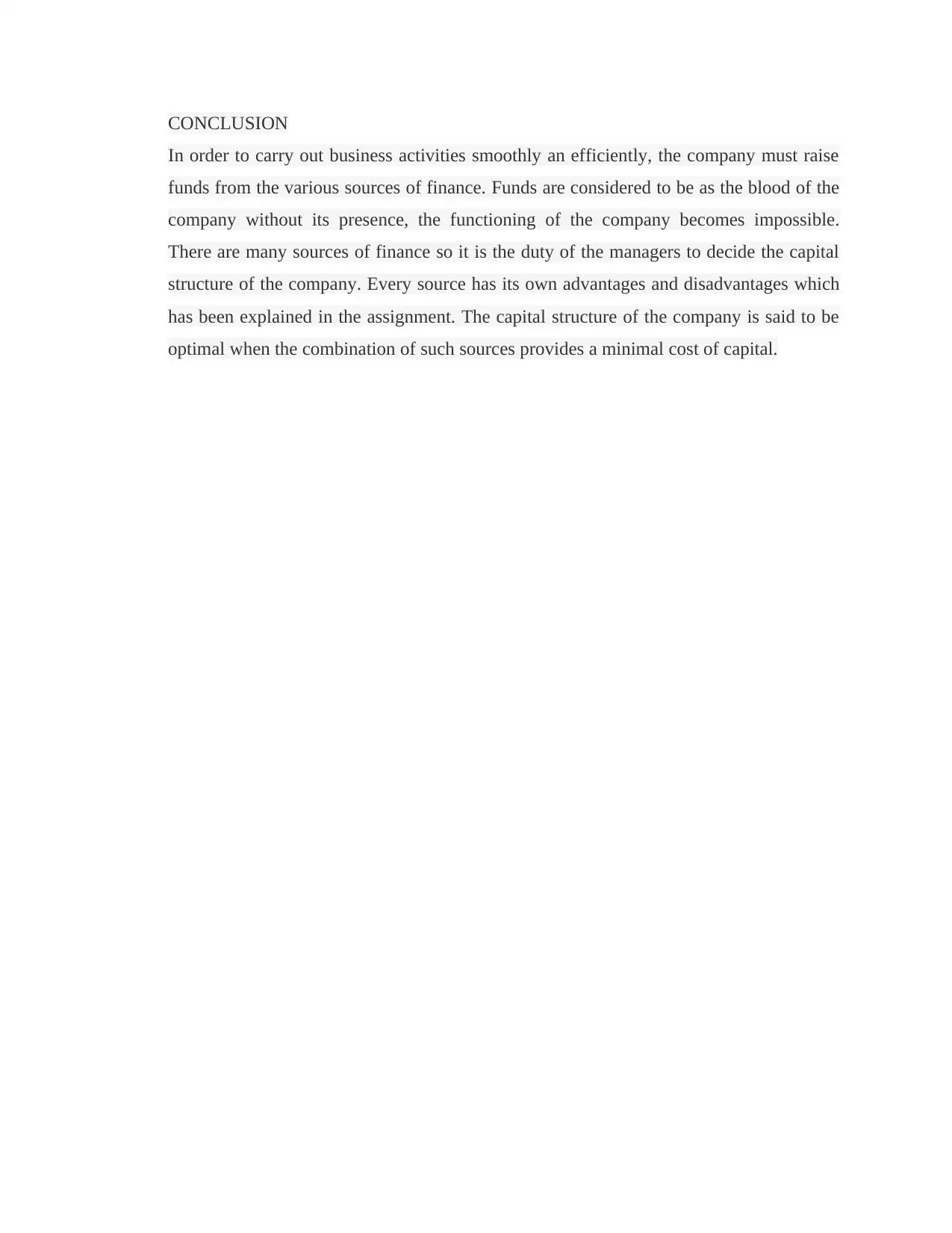
CONCLUSION
In order to carry out business activities smoothly an efficiently, the company must raise
funds from the various sources of finance. Funds are considered to be as the blood of the
company without its presence, the functioning of the company becomes impossible.
There are many sources of finance so it is the duty of the managers to decide the capital
structure of the company. Every source has its own advantages and disadvantages which
has been explained in the assignment. The capital structure of the company is said to be
optimal when the combination of such sources provides a minimal cost of capital.
In order to carry out business activities smoothly an efficiently, the company must raise
funds from the various sources of finance. Funds are considered to be as the blood of the
company without its presence, the functioning of the company becomes impossible.
There are many sources of finance so it is the duty of the managers to decide the capital
structure of the company. Every source has its own advantages and disadvantages which
has been explained in the assignment. The capital structure of the company is said to be
optimal when the combination of such sources provides a minimal cost of capital.
Paraphrase This Document
Need a fresh take? Get an instant paraphrase of this document with our AI Paraphraser
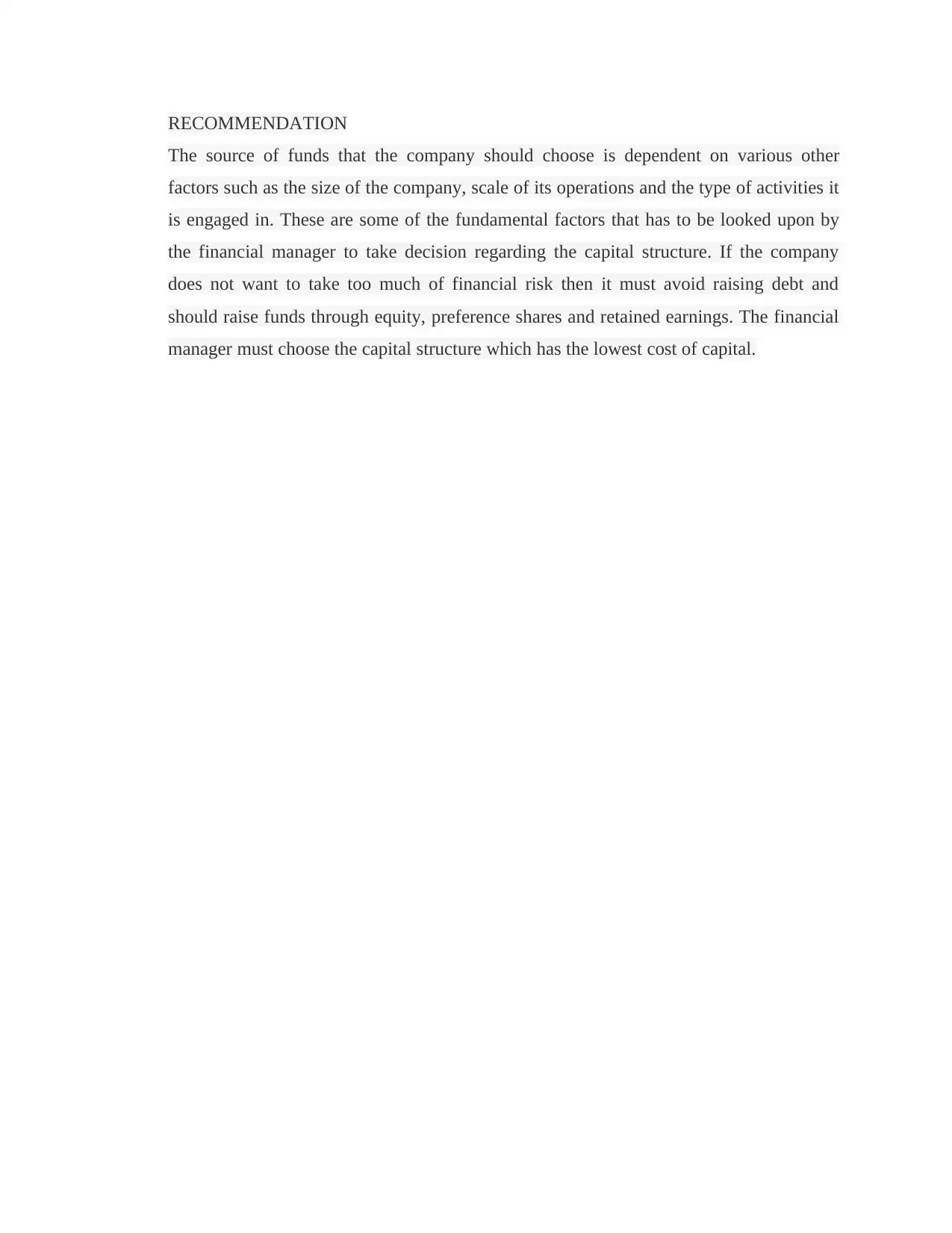
RECOMMENDATION
The source of funds that the company should choose is dependent on various other
factors such as the size of the company, scale of its operations and the type of activities it
is engaged in. These are some of the fundamental factors that has to be looked upon by
the financial manager to take decision regarding the capital structure. If the company
does not want to take too much of financial risk then it must avoid raising debt and
should raise funds through equity, preference shares and retained earnings. The financial
manager must choose the capital structure which has the lowest cost of capital.
The source of funds that the company should choose is dependent on various other
factors such as the size of the company, scale of its operations and the type of activities it
is engaged in. These are some of the fundamental factors that has to be looked upon by
the financial manager to take decision regarding the capital structure. If the company
does not want to take too much of financial risk then it must avoid raising debt and
should raise funds through equity, preference shares and retained earnings. The financial
manager must choose the capital structure which has the lowest cost of capital.

Bibliography
Atkinson, A. A. (2012). Management accounting. Upper Saddle River, N.J.: Paerson.
Berry, L. E. (2009). Management accounting demystified. New York: McGraw-Hill.
Boyd, W. K. (2013). Cost Accounting For Dummies. Hoboken: Wiley.
Holtzman, M. (2013). Managerial Accounting For Dummies. Hoboken, NJ: Wiley.
Horngren, C. (2012). Cost accounting. Upper Saddle River, N.J.: Pearson/Prentice Hall.
Jensen, M., & Meckling, W. (1976). Theory of the firm:Managerial behaviour, agency cost and
ownership structure. Journal of Financial Economics , 305-360.
Menifield, C. E. (2014). The Basics of Public Budgeting and Financial Management: A
Handbook for Academics and Practitioners. Lanham, Md.: University Press of America.
Robinson, T. (2014). Business accounting. New York, NY: Prentice Hall.
Seal, W. (2012). Management accounting. Maidenhead: McGraw-Hill Higher Education.
Siciliano, G. (2015). Finance for Nonfinancial Managers. New York: McGraw-Hill.
Simpson, M. (2012). Financial accounting. Basingstoke: Macmillan Press.
Atkinson, A. A. (2012). Management accounting. Upper Saddle River, N.J.: Paerson.
Berry, L. E. (2009). Management accounting demystified. New York: McGraw-Hill.
Boyd, W. K. (2013). Cost Accounting For Dummies. Hoboken: Wiley.
Holtzman, M. (2013). Managerial Accounting For Dummies. Hoboken, NJ: Wiley.
Horngren, C. (2012). Cost accounting. Upper Saddle River, N.J.: Pearson/Prentice Hall.
Jensen, M., & Meckling, W. (1976). Theory of the firm:Managerial behaviour, agency cost and
ownership structure. Journal of Financial Economics , 305-360.
Menifield, C. E. (2014). The Basics of Public Budgeting and Financial Management: A
Handbook for Academics and Practitioners. Lanham, Md.: University Press of America.
Robinson, T. (2014). Business accounting. New York, NY: Prentice Hall.
Seal, W. (2012). Management accounting. Maidenhead: McGraw-Hill Higher Education.
Siciliano, G. (2015). Finance for Nonfinancial Managers. New York: McGraw-Hill.
Simpson, M. (2012). Financial accounting. Basingstoke: Macmillan Press.
⊘ This is a preview!⊘
Do you want full access?
Subscribe today to unlock all pages.

Trusted by 1+ million students worldwide
1 out of 9
Related Documents
Your All-in-One AI-Powered Toolkit for Academic Success.
+13062052269
info@desklib.com
Available 24*7 on WhatsApp / Email
![[object Object]](/_next/static/media/star-bottom.7253800d.svg)
Unlock your academic potential
Copyright © 2020–2025 A2Z Services. All Rights Reserved. Developed and managed by ZUCOL.





